Introduction
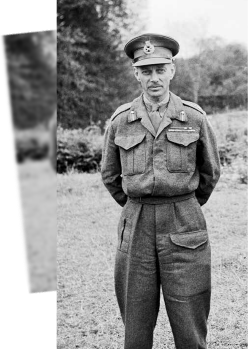
Then-Lieutenant-General Miles Dempsey, commanding British 2nd Army, in France, 16 July 1944
First things first: Who is Dempsey?
The road leading up to and around where Dempsey Hill is today was named after General Sir Miles Christopher Dempsey (1896–1969), a capable and highly regarded soldier who had a decorated military career.
While serving in North Africa, Sicily and Italy, Dempsey earned a reputation as an expert in combined operations. This landed him the role of commanding officer of the Second Army – the main British force involved in the D-Day landings in 1944. Along with Canadian troops, the Second Army made successful assaults at Gold, Juno and Sword beaches under Dempsey’s leadership.
During 1945, Dempsey was the Commander-in-Chief of the Allied Land Forces South East Asia (ALFSEA) and the General Officer Commanding the Malaya Command, which were both headquartered in Singapore.
Despite decades of service spanning two world wars, Dempsey’s modesty and persistent avoidance of the limelight has left him relatively unknown. Today, his memory and contributions are honoured on this eponymous road and hill.
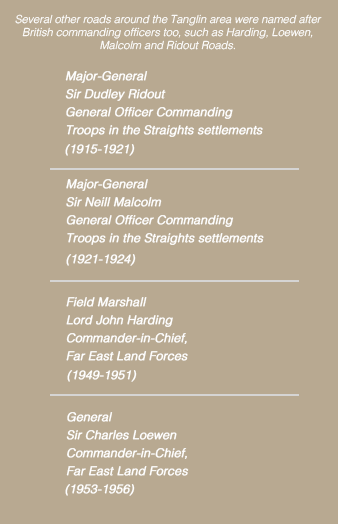
1850
Mount Harriet:
The grounds you now tread on used to be part of a huge nutmeg plantation in the 1850s called Mount Harriet. Colonial Treasurer William W. Willans and local businessman Whampoa Hoo Ah Kay co-owned the estate, which, with 1,600 trees, included the area where Singapore Botanic Gardens now stand.
When an outbreak of disease felled many plantations in Singapore, Mount Harriet was not spared. A nutmeg-beetle blight, “a curious disease of the nut, resembling leprosy in the human being”, eventually caused the estate to cease operations in 1857.
Though the plantation was extremely profitable for a period of time, the nutmeg blight caused Mount Harriet to become commercially unviable. Probably eager to get the plot off their hands and move on, Willans and Hoo sold the land to the British Forces in May 1860 for a modest sum of 25,000 Spanish dollars.
In 1843 the district of Tanglin consisted of barren-looking hills covered with short brushwood and lalang. This was the result of the deserted gambier plantations, and immediately on the inauguration of granting land in perpetuity in that year a large number of nutmeg trees were planted in this district.
... The plantations …[that] surrounded the country residences were very luxuriant, and when the fruit was on [the nutmeg trees] the odour was quite delightful. ... Tanglin must have been a very beautiful place at this time, a veritable spice garden.
– From One Hundred Years of Singapore
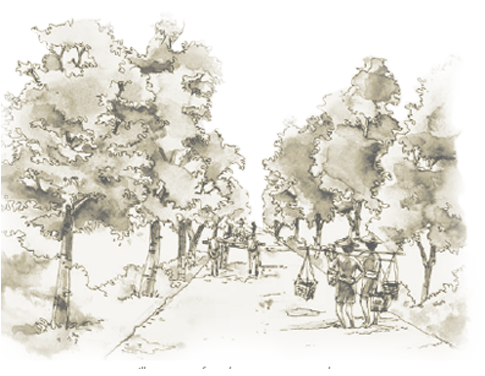
Illustration of workers in a nutmeg plantation

"Whampoa" Hoo Ah Kay
Who’s Ah Kay?
Better known as Whampoa, Hoo Ah Kay (1816–1880) was a prominent businessman and office-holder in Singapore in the nineteenth century. Born in Whampoa, China, Hoo immigrated to Singapore when he was fourteen and worked at his father’s food supply company Whampoa and Co., which he inherited after his father’s death. As the business became better known in Singapore and the region, people came to know him by Whampoa instead.
Hoo's fluency in English allowed him to hold many high-ranking positions within the colonial government. He was the first Consul for China in Singapore in 1877, the Japanese honourable consul in Singapore in 1879, and the first and only Chinese extraordinary member of the Legislative Council.

Members of the first Straits Settlements Legislative Council in 1873; Hoo is second from right
1861
Tanglin Barracks:
The purchase
In the 1850s, the British Empire faced political unrest in her colonies and against other countries, namely the Indian Mutiny of 1857 and the Crimean War. This prompted the British government in Singapore to further fortify the island, a commercially and militarily important colony of Great Britain, and house European troops separately from native soldiers. To prepare for and house the influx of British troops, the government bought over Mount Harriet and started construction for Tanglin Barracks.
Before the purchase, garrisons in Singapore were mostly located at Fort Canning and areas around the city centre. Their proximity to the commercial district caused merchants to worry that their warehouses would be destroyed during a military crossfire. Acknowledging their concern, the British government bought the Mount Harriet plot, which was in an outlying area, to station the new troops.
Under the supervision of Colonel George Chancellor Collyer, Chief Engineer of the Straits Settlements, construction for Tanglin Barracks began in 1860. The first barracks were built at the area where Dempsey Hill and the Loewen cluster are now. There were ten service barracks for 50 men each. In addition, there were wash and cookhouses, hospital wards, a school, reading room, library and
officers’ quarters.
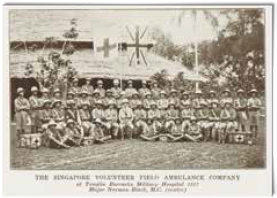
From A history of the Singapore Volunteer Corps, 1854–1937: being also a historical outline of volunteering in Malaya, by T. M. Winsley, 1938, Singapore: Government Printing Office (Image courtesy of the National Library, Singapore. All rights reserved, National Library Board, Singapore 2014)
Barrack Architecture
With thatched attap roofs and square columns, the original structures at Tanglin Barracks incorporated plenty of windows and doorways to provide as much fresh air as possible. To keep the barracks breezy and help the incoming European regiment combat Singapore’s tropical heat, raised wooden floors and plank walls were used while open verandahs wrapped around each building.
In 1911, the thatched roofs were replaced with more durable red French tiles that have remained to this day.
The charming architectural features of these barracks are protected under Singapore’s conservation guidelines and can still be admired in Dempsey Hill today.
The name Tanglin probably came from the Chinese dialect words tang leng, meaning "eastern hillocks", taking its bearing from Chinatown. In the early 19th century, Chinese businessmen ventured east of Chinatown to establish plantations in the hilly Tanglin area. Afterwards, the Europeans also came to Tanglin to set up their own plantations and build residences on the hills.
Expansion and Improvements
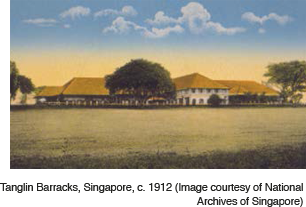
Even though construction of the Barracks was completed in 1861, the buildings were not occupied until 1867. Before troops from the 80th Foot Staffordshire Volunteers arrived, the Barracks underwent renovations and a hospital was added. The 240-bed Tanglin Hospital was used as a military hospital for British forces until 1940, when increased troops in the years preceding World War II called for a larger hospital. The Military Hospital was then transferred to Alexandra Hospital.
Upper Tanglin has a Tamil name, Vampumalei, which translates to "Whampoa's Hill", probably referring to part of Mount Harriet.
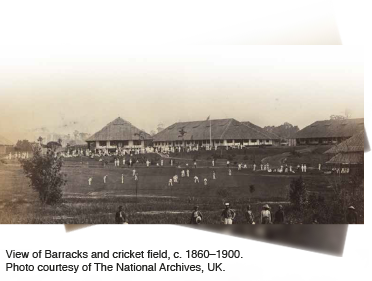
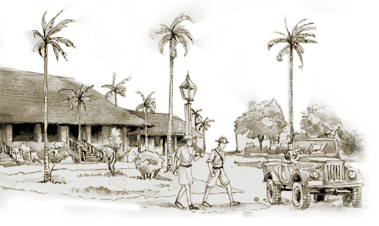
Illustration of British Soldiers roaming the grounds of Tanglin Barracks
Major C. H. Malan, Commanding Officer at Tanglin Barracks from 1868 to 1870, described the living conditions of the area then:
I found, on my arrival there, that the men of my regiment were in a state of the utmost discomfort. The barracks ... had been built in the centre of a tropical jungle which swarmed with cobras, rats, frogs, and mosquitoes ... . The rats ate the men’s things; the snakes came into the barracks; the frogs croaked all night; the mosquitoes gave them no sleep. … Add to this, the intense heat.… [T]he discomfort of the barracks; and the heat, and sleepless nights, and no out-door recreation, caused a crowded canteen, and a great deal of drunkenness.

Locals helping the 1st Battalion, Wiltshire Regiment, with cable laying at Tanglin Barracks, Singapore, 1934
Malan sought to improve the situation by clearing the dense vegetation, constructing a cricket field, gymnasium, rifle range and even small gardens. With the jungle cleared and slopes levelled, the "once gloomy barracks were now brilliant with colour".
While the soldiers carried out most of the improvements, the locals provided much needed expertise. Malan employed locals, including his own gardener, to work with and show his men the way to go about clearing the jungle. Describing his gardener as "a very intelligent man", Malan hired another eight Malay labourers to work under the gardener. "As fast as [the jungle] was cut down by the Malays, the British soldiers gathered it, and then with pickaxes, they dug up the roots and carted it away" – the colonial soldiers and locals truly worked hand-in hand to improve the environment of Tanglin Barracks.
1884
St George’s Church:
When the Barracks were built, there was no church nearby and services were held privately in the barracks without an official chaplain presiding over them. Commanding Officer Major C. H. Malan took on the role of lay chaplain and supervised the building of a garrison church.
It is not known exactly where this first garrison church was built, but by 1910 the congregation had outgrown it and a larger building was erected. William Henry Stanbury, a member of the Royal Engineers and a Fellow of the Royal Institute of British Architects, designed the church in the classical Basilica style of the Romanesque tradition.
Known as St. George’s Garrison Church in the early years, the building has continued as a place of worship to this day. On 25 October 1971, after the British forces had withdrawn from Singapore, the church became a civilian church and was incorporated into the Anglican Diocese of Singapore.
The redbrick church building was gazetted on 10 November 1978 as a national monument of Singapore. Today St. George’s is a growing international Anglican church.
The church was built like a long rectangular barn – a form perfected by the Greco-Romans centuries ago. While elegant in its simplicity, the building also projects an honest, robust character with its exposed red brick and mortar.
For more information about St. George's Church services, visit www.stgeorges.org.sg/services.
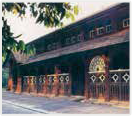
Architectural features on the side of the church building

The church was built like a long rectangular barn – a form perfected by the Greco-Romans centuries ago. While elegant in its simplicity, the building also projects an honest, robust character with its exposed red brick and mortar.

Aerial view of St. George's Church in the old days; the hut on the left of the photograph is the chaplain’s quarters
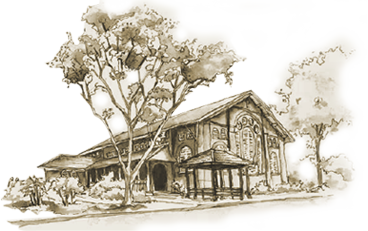
During World War II
During the war, Japanese forces took over the garrison church and its premises to store ammunition. The chaplain’s quarters (present-day St. George’s Centre) were ransacked and occupied by an assistant quartermaster of the Imperial Japanese Army in charge of the ammunition stored in the church. The local
Japanese commandant later occupied those quarters.
For fear that the war would destroy the beautiful but fragile pieces of stained glass, the colonial chaplain dismantled and hastily buried the original windows of St. George’s Church just two days before British forces surrendered. The stained glass windows were intended to be shipped overseas to safety, but what exactly happened has never been uncovered.
Unfortunately, the chaplain did not survive his internment and the fate of those glass windows was lost along with his life. Intensive searches conducted since have not turned up anything; thus the whereabouts of the original stained glass windows have remained a mystery to this day.
1915
A rebel movement was brewing in India in the early 1900s to oust the British government by means of an armed revolution. The anti-colonial Ghadar Party sought out Indian soldiers posted overseas and spread propaganda to them, encouraging them to rise against the British. This affected troops stationed in Singapore, the Muslim 5th Light Infantry being one of them. Low troop morale, slack discipline and weak leadership further contributed to their dissatisfaction, which culminated in the Indian Mutiny.
1915 Indian (Singapore) Mutiny
On 15 February 1915, amidst World War I, a group of about 800 sepoys (Indian soldiers) from the 5th Light Infantry mutinied against the British forces in Singapore. With troops deployed to fight the war in Europe and ongoing Chinese New Year celebrations, Singapore was
caught unprepared when the sepoys took to the streets and shot at any Europeans they saw. The bloody incident came to be known as the "Singapore Mutiny", and locally as the "Sepoy Mutiny" or "Indian
Mutiny".
Mutineers broke into Tanglin Barracks unannounced, killing the officers they came across, and freed Germans interned there. Some prisoners escaped, but most others stayed put and refused to join the rebellion.
It was a time of fear and chaos. Martial Law was declared and European women and children were evacuated to hotels and put on ships in the harbour, "which waited with steam up, ready to get away
should the necessity arise".
Even though the Singapore Volunteer Corps responded quickly to the emergency, it still took more than seven days and reinforcements from other British and Allied forces before peace was restored.
On the 20th anniversary of the Mutiny, The Straits Times published several articles remembering and commemorating the incident. A European woman recounts her experiences:
We were out of our home for a week, and others as much as three weeks, according to the locality in which they lived, before all districts were declared safe to return to, and during all this time the servants of all nationalities were simply marvellous. They came to and fro, bringing us clothes and other necessaries – they had the houses entirely to themselves... so we were completely at their mercy, yet not a single case of theft on their part was reported, a fact never to be forgotten. ... Eventually we returned home to find the house spotlessly clean, flowers arranged, silver gleaming, and tea laid – truly thankful to have come safely to the end of a unique and interesting, though some what alarming experience.
1942
World War II and Japanese Occupation
World War II affected Singapore and her people greatly. When the colonial government surrendered on 15 February 1942, the soldiers defending Singapore suddenly became prisoners of war (POWs).
Before many of them met their untimely demise, most famously while working on the Thailand– Burma Railway, British and Australian troops were gathered at Tanglin Barracks – the place where they lost their freedom to the war.
The March from Tanglin Barracks to Changi Gaol
In an article published in a 1944 issue of The Argus, an Australian Army driver recounts the "black day for the defenders of Singapore":
About 8pm, we were told by our OC (Officer Commanding) that Singapore had fallen and that we were now prisoners of war. ... The next day we marched to the Tanglin Barracks to hand over our arms and equipment to the Japs. ... In the afternoon we began a nightmare march to Changi camp, 15 miles north [east] of Singapore. ...About 15,000 Australians marched to Changi, and many fell out on the roadside to sleep as night came on. I reached Changi at 3am.
The "nightmare march" to Selarang Barracks, Changi took about 14 hours.
In an especially poignant passage, Colonel Colin Tuckfield from Kenmore, Queensland reminisced:
My mind wanders back to that day ... when we sat in utter bewilderment in our slitties outside Tyersall Palace, savouring the utter silence, rendered more so by the occasional rifle shot, which followed the days of bombardment. It was a day of contrast – of noise and quiet, of war and “peace”, of freedom and imprisonment, of ugliness and beauty
– yes, even beauty.
Do you remember when we passed out of the chaos which was Singapore, with its corpsechoked canals, its smoke and stench, the tangle of trolley wires and the wreckage of buildings; how marching to Changi in the evening, we passed a spot where, in lovely silence, millions of fireflies were blinking on and off like Christmas tree lights? It was, for some, the last beauty they beheld.
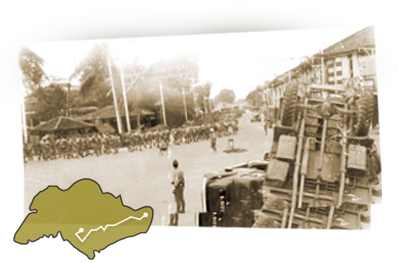
British prisoners-of-war marching on the road to Changi during Japanese Occupation, 1942 (Image courtesy of National Archives of Singapore)
Interned at Tanglin Barracks

During the occupation, the Japanese also used the Barracks to store medical supplies and house POWs. Elliott McMaster of the 2/20th Battalion A.I.F. was among those sent there in 1942. Assigned to labour for a Japanese field hygiene unit, McMaster loaded and unloaded supplies from ships and transported them on trucks to the Barracks. Useful supplies from chemist shops throughout Singapore were taken by the Japanese too.
According to McMaster, the interned soldiers "pinched large quantities of ... very valuable, rare and up-to-date drugs" that were smuggled to Changi Hospital. This underground activity in Tanglin Barracks was claimed to have “virtually supplied all Changi Hospital drugs and medicines.”
1945
General HQ of the Far East Land Forces
After more than three-and-a-half years of suffering, Singapore was returned to the British when Japanese forces in the region formally surrendered on 12 September 1945. Following the surrender, British forces retook Tanglin Barracks and assigned it as the General Headquarters of the Far East Land Forces. Once again, expatriate soldiers, officers and their families roamed the grounds of Tanglin.
With them also came locals who lived, worked and played in the area. From civilian staffers to shop owners, Singaporeans contributed to the life of then-Dempsey Hill. Gina Ho’s parents were among these residents. They ran a small shop in the area from 1958 to 1970, where Ho spent her childhood running around the verdant grounds of Tanglin Barracks, interacting with British soldiers.
With a fine tradition of parties, dances and balls dating back to its early days, the garrison and its occupants continued this merrymaking after the war. According to Ho:
The British ... celebrated Christmas and Easter in a very big way. The British fancied cooking their food with butter. We could smell butter wafting from the kitchen all day. ... My uncle was their favourite chef. Naturally, I had my fair share of tasty English food like roast turkey, roast potatoes and lamb chops.
The soldiers held regular sporting events as well, pitting different regiments and troops in Singapore against each other in swim meets, boxing tournaments, cricket matches and more. Clearly, beyond its military vocation, the Barracks served as a significant centre of social activity for various communities in Singapore.
Here, Gina Ho describes the locality then:
A very quiet place with lots of fresh air; [it] was very self-contained. The facilities ... included two churches, a kindergarten, a broadcasting station owned by the Gurkhas, swimming pool, theatre, tailor, a few football fields, dancing hall, offices, Commander’s office, tennis court, basketball court, golf club, landing field for helicopters, post office [and a] POSB bank.
Some houses were built for the British soldiers and their families, some were built for bachelors. A British family built a tree house in one of the big trees. In the evenings, I would climb to the tree house and read my storybooks. I did not have many storybooks then, so I ended up reading my second brother’s Chinese books. As a result, my command of the Chinese language was fantastic. My brother was in preuniversity; I was about nine years old.
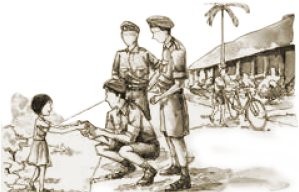
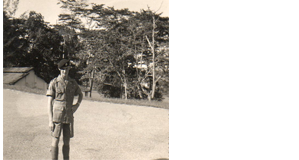
1989 - 2006
Blocks in Loewen area, then part of CMPB, housed the SAF Music and Drama Company (MDC) too. MDC was a springboard for the career of many local celebrities and artistes such as Gurmit Singh (comedian, actor, host), Jack Neo (comedian, producer, director), Ivan Heng (stage actor, director) and Kumar (stand-up comedian, drag queen, TV host, actor).
Civil servants' recreational club
With ample space and fresh air, the Tanglin locale was also where, in 1971, the Singapore Civil Service Sports Council (SCSSC) was founded. Focused on its vision to “promote sports, fitness and recreational activities the Public Officers”, SCSSC opened Dempsey Clubhouse – its first clubhouse on Dempsey Road – originally a British sergeants’ mess.
A year after its official opening, SCSSC inaugurated the interterritorial games between civil servants from Singapore and Malaysia. The Games were held twice yearly and when Singapore competed at home, the Clubhouse provided facilities for the sport events – a fitting continuation of a centuries-old tradition of sports and competition on the Tanglin grounds
SCSSC moved out of its Tanglin premises in 1975. Today, you can find the legendary Samy’s Curry in the same space.
In recognition of women’s growing involvement in sports, the interterritorial games included women for the first time in 1974
Former MINDEF HQ and Central Manpower Base(CMPB)
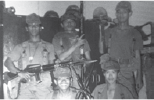
After a tumultuous few years, Singapore gained her independence on 9 August 1965. The British forces started withdrawing their troops from the country in 1971. The last soldiers left in 1976 and Singapore’s government gained ownership of Tanglin Barracks.
Military Headquarters
The Barracks remained unused until the Ministry of Defence (MINDEF) made the compound its headquarters in 1972, having split from the Ministry of Interior and Defence in 1970. The Singapore Armed Forces (SAF) had different agencies and departments in the area, including the Tanglin Dental Centre, Foreign Military Liaison Branch and SAF Music and Drama Company, which produced many popular local artistes and comedians.
The property also housed the Central Manpower Base (CMPB), where 18-year-old boys starting their National Service (NS) reported to the military. Paul Ang, a Singaporean who reported and served his NS at CMPB then, recalls how young men would first report at the Registration and Recruitment Centre at block 17, before getting their medical check-up at block 15’s Medical Classification Centre. On enlistment days, parents gathered at the parade square between blocks 15, 17 and 18, where their sons formed up and boarded 3-tonne trucks to be transported to their camps.
According to Ang, who worked for the Records Branch in the Control of Personnel Centre back in 1986, several of the blocks at the Tanglin camp were known to be haunted. The soldiers regularly witnessed supernatural incidents, which were often related to the Barracks’ history as a British garrison and subsequently a Japanese-occupied camp.
Nonetheless, Ang remembers his time at CMPB very fondly and appreciates the transformation it has gone through. He shares: "I love the fact that the sleepy CMPB of yore has turned into a lively village of sorts. I eat and drink there, shop at Lotto Carpets Gallery and Asiatique Collections, and even visit the art galleries. [These are] all nice to have at Dempsey [Hill]."
2007 - Present

Dempsey Hill
Tanglin Camp, as it became known, was vacated in 1989 and handed over to the Land Office, which leased the barracks out to the private sector. The nineties saw the area gradually transform into a quaint retail enclave known for its antique, carpet and furniture warehouse stores.
The increasing appeal of this bohemian enclave prompted the Singapore Land Authority to redevelop and rebrand Dempsey Road in August 2006 as Tanglin Village – a 40-hectare site with artistic, educational and lifestyle offerings.
For many younger Singaporeans, their first memory of Tanglin Village is when it was used as one of the exhibition sites for the Singapore Biennale held in November 2006. Not too long after, a property investment company called Country City Investment won the tender for the first site on Dempsey Road and officially launched the awarded areas as Dempsey Hill on 12 July 2007.
Just a few minutes from Orchard Road, this tranquil hideaway is a well-loved lifestyle destination for locals and expatriates alike. Surrounded by nature’s lush greenery, the little hill is filled with gourmet grocers, art galleries, antique shops, highly acclaimed restaurants, cafés and wine bars. Whether in the day or at night, there is something for everyone in this charming enclave.
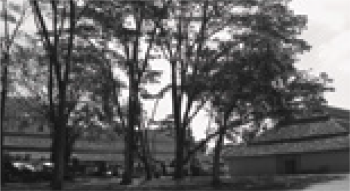
View of Dempsey Hill right before restoration works were done
Loewen by
Dempsey Hill
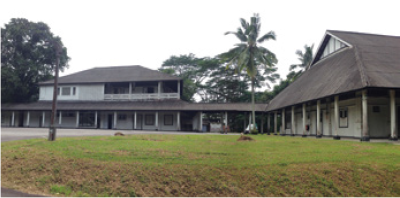
Part of Loewen by Dempsey Hill
On 9 May 2013, Chanel hosted its eagerly anticipated Cruise Collection 2013/2014 event in a state-owned portion of the compound. The star-studded runway event was the first
ever in Asia, and the legendary Chanel creative director Karl Lagerfeld made an appearance that night, along with 40 international models and numerous celebrities.
Located where the military hospital used to stand, Loewen by Dempsey Hill will be transformed into an education and lifestyle destination offering restaurants, pottery classes, art classes, chocolate- making classes, programmes for children, and more.
The old hospital was built in 1870 and in those days, it overlooked the officers’ bungalows and messing facilities at one end of the camp and housing facilities for the rest of the regiment at the other. Between the two housing areas were the parade ground and the garrison church.
The 9th Division/Infantry, formed on 1 October 1978 as a “Reserves” Division had its beginnings in a quiet cluster of buildings at the Loewan Road Camp. By 1984, its strength and numbers had grown so much that the Panthers had to move to Selerang Camp.Today, the 9th Singapore Division and Infantry Formation is no longer a “reservist” Division but a regular combined arms division made up of active soldiers and NSmen.
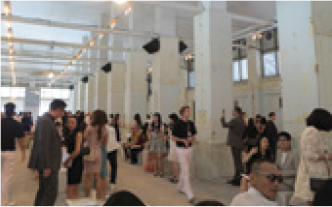
Chanel’s cruise collection 2013/2014 runway show
Loewen by Dempsey Hill
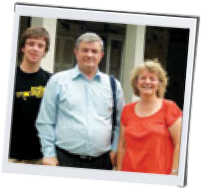
Coming back to Dempsey Hill is always a very nostalgic experience for the Traynors. Back in the day, when Carol was a 19-year-old private serving in the 4th Company of the Women’s Royal Army Corps in the 1960s, she met and fell in love with a dashing corporal from the 18th Signal Regiment at the old Tanglin Barracks.
"Blocks 71–74 housed my entire unit. It’s as if I can still hear the voices of us young excited girls chatting while getting ready for work, then in the evenings dressing up to go out socialising in The Phoenix Club in Harding Road. I also remember lying on my bed with the doors open watching the monsoon rains come down like a curtain; the chichaks as we called them (small lizards) darting across the rafters in the roof; walking past the laundry room where the laundry women washed our tropical dresses, and walking down the road on the way to work and seeing the many exotic plants, flowers, and butterflies that I could never see back in England," said Carol wistfully.
According to Jim, Block 75J Loewen Road used to be a medical facility and a lovers’ haunt for couples at night. He quipped, "That’s where we would have our goodnight smooches before returning to our barracks."
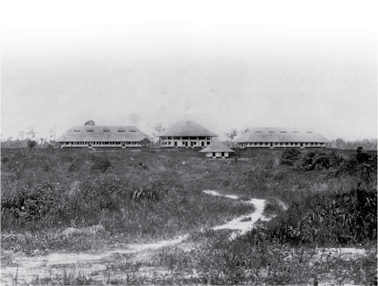
Photograph of Tanglin Barracks with their thatched roofs, 1871 (Image courtesy of St. George’s Church)